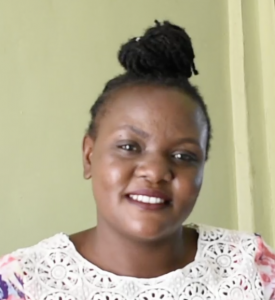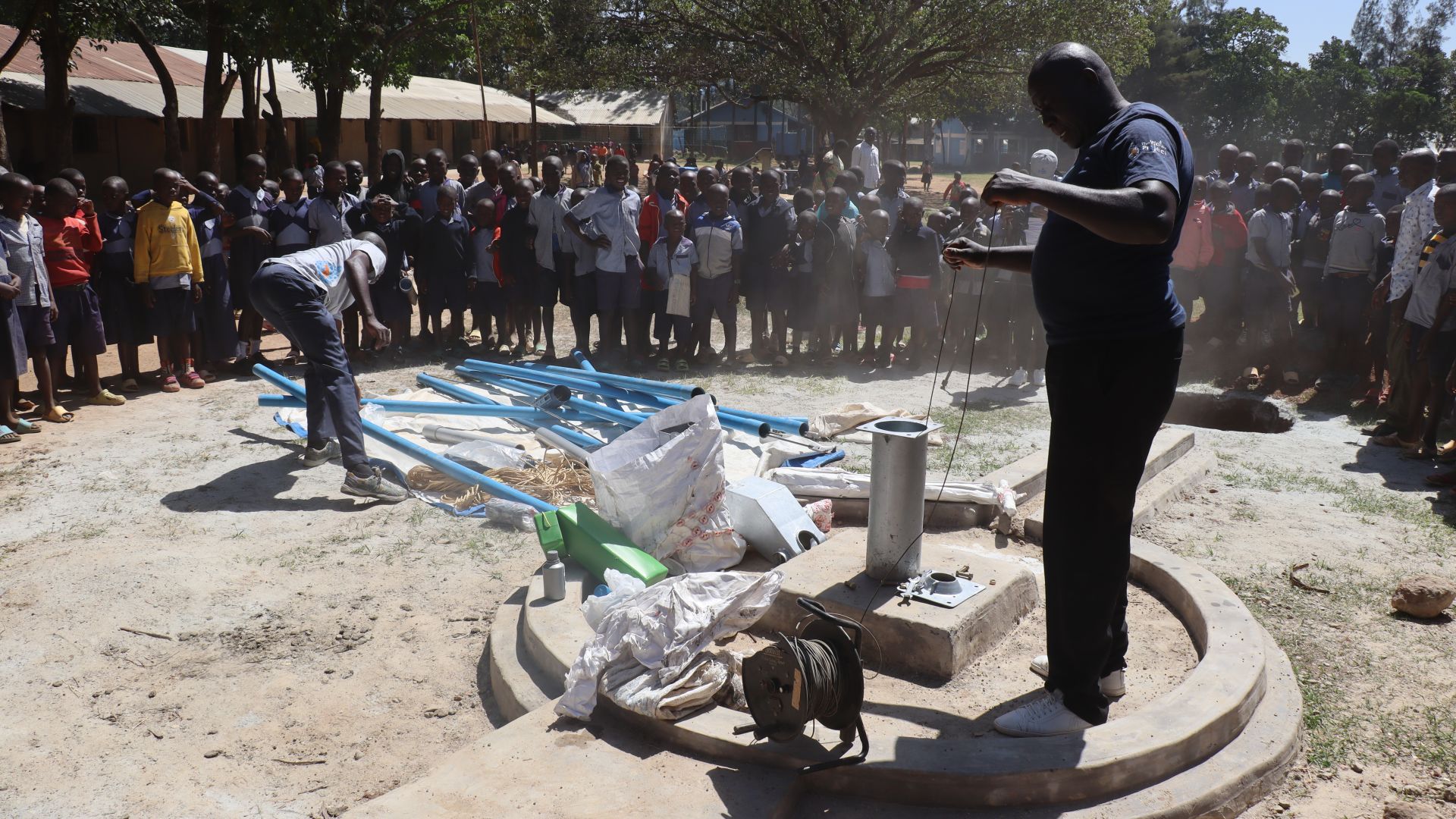The 1,261 students of St. Peters Khaunga Primary School struggle to access sufficient water to meet their daily needs. The school relies on a rundown rainwater storage tank to hold collected rainwater, but it is never enough, especially during the dry season. Students do their best to haul water to school to supplement the tank's water supply, but the water they find is often contaminated, putting everyone at risk.
"The water that has been brought in [to] school, especially from the unknown sources, has caused children to fall sick. Most of the students have suffered from typhoid, diarrhea, and stomachache issues," shared Field Officer Adelaide Nasimiyu.
12-year-old student Lewis shared his experience of suffering from water-related illnesses.

Lewis by the water taps from the rain tank.
"I get sick more often because of water [from] the water we drink at school when it is not from the tank. I always fall sick drinking water that is brought from outside of the school compound. This water is not treated, and since you are thirsty, you have to drink it the way it is," said Lewis.
"I remember the last time I became sick. I was so weak because of diarrhea and vomiting. I was too weak to stand and walk on my own. I had to be supported by someone to get up from bed and even go to the latrine. My parents took me to the hospital to ensure that I got the best treatment. They supported me to ensure that I get meals that [are a] clean and balanced diet. This made me feel much better because I was satisfied that my parents care about me and are concerned about my health."

Lewis.
"When you are sick, you have to miss school so that you can go to the hospital for treatment. When you come to school while you're sick, you will not concentrate in class and disturb other students."
Suffering from water-related illnesses not only takes a toll on Lewis' health but also puts him behind academically.
Lewis misses school when he is ill, but that is not the only time he misses class. Although most students arrive with water first thing in the morning, what they bring is rarely enough for the day. As a result, they are often sent back out to find more water during the school day. This task brings anxiety to Lewis and steals more of his time and energy, making progress difficult.

Students waiting to fill their containers from the rain tank.
"I'm worried about the insufficient water at school. We only have water during the rainy season. During the dry season, we have to go to the stream to get water," continued Lewis.
"When we are being sent to fetch water outside the school compound, that is where it takes [a] long [time]. The water point where we fetch water is a bit far away from the school. Sometimes, you [will] find a long queue at the water point, and you can not force your way to the front, so you have to wait for your turn to fetch water. Sometimes, the community members where we fetch water are hostile towards us."

Students going to collect water.
Lewis dreams of a day where he has clean water access at his fingertips anytime he needs it.
"The new water point will help us have water throughout the year. This will assure us of not going to the community to search for water. The water we will access at school will be clean and safe to drink. We will not be worried of getting sick because of drinking dirty water."
"I will use my time to revise where I didn't understand while the teacher was teaching to be able to catch up with other students. I will also have time to play with my friends during break time and in the evening during game time," concluded Lewis.
Steps Toward a Solution
Our technical experts worked with the local community to identify the most effective solution to their water crisis. They decided to drill a borehole well, construct a platform for the well, and attach a hand pump.
Well
Abundant water often lies just beneath our feet. Aquifers—natural underground rivers—flow through layers of sediment and rock, offering a constant supply of safe water. A borehole well is drilled deep into the earth to access this naturally filtered and protected water. We penetrate meters, sometimes even hundreds of meters, of soil, silt, rock, and more to reach the water underground. Once found, we construct a platform for the well and attach a hand pump. The community gains a safe, enclosed water source capable of providing approximately five gallons of water per minute. Learn more here!
Handwashing Stations
Alongside each water source, we install two gravity-fed handwashing stations, enabling everyone at the school to wash their hands. Handwashing is crucial for preventing water-related illnesses within the school and community. Student "health clubs" maintain the stations, fill them with water, and supply them with soap, which we often teach them how to make.
Latrines
We will construct two Ventilated Improved Pit (VIP) latrine blocks designed to prevent fecal disease transmission. Each latrine features a cement floor, making it easy to use and clean regularly. Three stalls will serve the girls, and three will serve the boys.
School Education & Ownership
Hygiene and sanitation training are integral to our water projects. Training is tailored to each school's specific needs and includes key topics such as proper water handling, improved hygiene practices, disease transmission prevention, and care of the new water point.
To ensure a lasting impact, we support forming a student health club composed of elected student representatives and a teacher. These clubs promote hygiene practices schoolwide and keep handwashing stations well-stocked. This student-led model encourages a sense of ownership and responsibility.
Safe water and improved hygiene habits foster a healthier future for everyone in the school and the surrounding community.

 Borehole Well and Hand Pump
Borehole Well and Hand Pump
 Rehabilitation Project
Rehabilitation Project

































